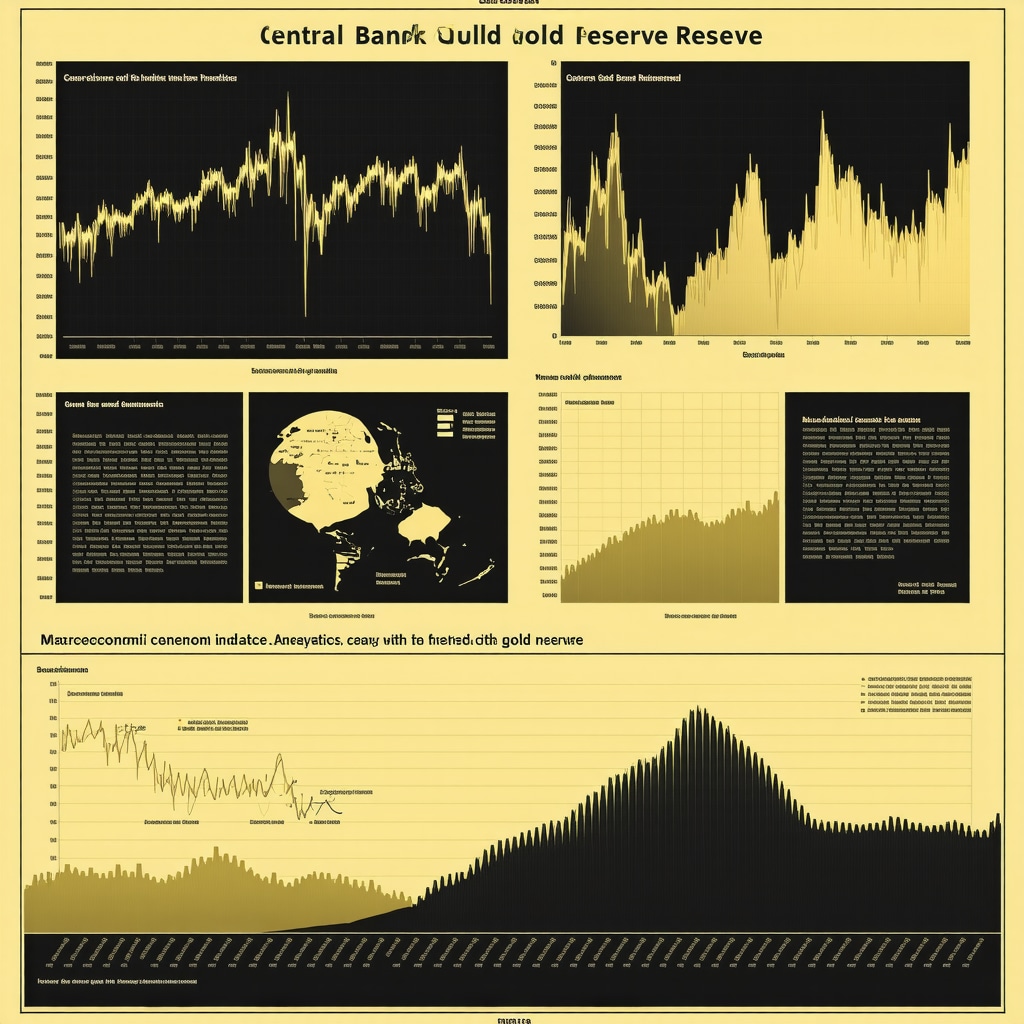Unveiling the Golden Grip: Central Banks as Pivotal Market Players
In the intricate tapestry of global financial markets, central banks stand as influential custodians of monetary stability and economic confidence. Their strategic gold purchases are not mere portfolio diversifications; they are powerful signals that reverberate through worldwide demand channels and price mechanisms. Understanding how these sovereign entities drive gold demand and prices requires a deep dive into their motivations, market behavior, and the cascading effects on investors and economies alike.
Strategic Reserves and Global Confidence: Why Central Banks Buy Gold
Central banks accumulate gold primarily to bolster national reserves, hedge against currency risks, and safeguard economic sovereignty amidst geopolitical uncertainties. Unlike other assets, gold offers a unique blend of liquidity, intrinsic value, and independence from any single currency or government. This strategic positioning elevates gold’s status and intensifies demand whenever central banks increase their holdings, signaling confidence or caution in the global economic landscape.
How Do Central Bank Gold Purchases Influence Global Market Prices?
Central bank acquisitions often trigger a ripple effect across the commodities market. When substantial volumes of gold are purchased, market perception shifts, prompting private investors and institutional players to anticipate scarcity and price appreciation. This anticipation can stimulate speculative buying, further amplifying demand and driving prices upward. Additionally, these purchases may tighten supply temporarily, especially when central banks source physical gold from bullion markets, creating upward pressure on pricing.
The Nuances of Supply Dynamics: Central Banks as Market Stabilizers and Disruptors
While central banks can act as stabilizers by providing steady demand, their buying patterns can also introduce volatility. For example, coordinated purchases by multiple central banks can lead to rapid price surges, while sporadic selling or leasing of gold reserves might temper market movements. The dual role of central banks underscores their profound influence over gold’s supply-demand equilibrium, making their actions closely monitored indicators for traders and analysts.
Practical Implications for Investors: Reading Between the Lines of Central Bank Activity
For savvy investors, central bank gold purchases serve as a barometer of economic sentiment and a harbinger of market trends. Recognizing patterns in these purchases enables investors to align their portfolios proactively, whether by increasing exposure to physical gold, gold ETFs, or mining stocks. Comprehensive insights into central bank behavior can be found in detailed market analyses such as those on Buying Old Now, which explore how these dynamics shape investment strategies and risk management.
Historical Perspectives: Case Studies in Central Bank Gold Buying and Market Impact
The post-2008 financial crisis era offers a vivid example where central banks, notably in emerging economies, significantly expanded gold reserves to diversify away from the US dollar. This surge contributed to a robust bull market in gold prices, highlighting how aggregate central bank policies can redefine global market trajectories. Such historical case studies provide critical lessons on the interplay between sovereign gold accumulation and commodity markets.
Engage with the Market: Share Your Insights and Experiences
Have you noticed shifts in gold prices following major central bank announcements? Share your thoughts or experiences in the comments below to foster a richer understanding of this complex but fascinating dynamic.
For those interested in deepening their knowledge about gold investment strategies influenced by global demand trends, consider exploring this comprehensive analysis that unpacks the broader market implications.
According to the World Gold Council, central banks have been net buyers of gold for several consecutive years, underscoring a sustained shift in reserve diversification priorities (World Gold Council – Central Bank Gold Reserves).
When Central Banks Move, How Should Individual Investors Respond?
I’ve often found myself pondering the ripple effects when central banks make significant gold purchases. Their moves can seem daunting, almost like a chess game played on a global scale. But from my experience, these signals are invaluable guides rather than sources of anxiety. When a central bank ramps up its gold reserves, it often reflects concerns about currency stability or inflationary pressures. Recognizing this early can help individual investors adjust their gold investment strategies proactively.
For instance, I remember reading a detailed report by the World Gold Council that highlighted how sustained central bank buying has historically preceded gold price rallies. This insight encouraged me to diversify my portfolio, not just by adding physical gold but also by exploring gold ETFs and mining stocks. This multi-pronged approach helps balance liquidity needs and potential growth, especially in volatile markets.
Have You Ever Adjusted Your Gold Investment Based on Central Bank Announcements?
I’m curious—have you noticed shifts in your own gold investments following major central bank moves? Maybe you decided to buy gold coins after hearing about a central bank’s acquisition spree or shifted to gold mutual funds anticipating price changes. Your experiences could offer practical wisdom to others navigating this complex terrain.
Engaging with communities and reading firsthand accounts has been a cornerstone of my investment approach. It’s one thing to grasp the macroeconomic theories but quite another to see how these trends play out in real-world portfolios. If you’re interested in exploring how to build a diversified portfolio with gold ETFs, I found this guide particularly helpful.
Balancing Act: Physical Gold Versus Gold Securities
One personal challenge I faced was deciding between holding physical gold and investing in gold securities like ETFs or mutual funds. Physical gold offers tangible security and a hedge against systemic risks, but it demands careful storage and insurance considerations. On the other hand, gold ETFs provide liquidity and ease of transaction but come with counterparty risks and management fees.
Over time, I’ve found that a hybrid strategy works best for me. I keep a portion of my investment in physical gold, especially coins and bars from reliable sources—taking care to apply best practices for safe storage as outlined in resources like this expert guide. Simultaneously, I allocate funds to ETFs to capitalize on market liquidity and potential price appreciation.
Understanding the nuances of each investment vehicle and aligning them with my risk tolerance and investment horizon has been instrumental in managing my portfolio effectively.
Insights from Market Trends: Staying Ahead with Continuous Learning
Market dynamics around gold are continuously evolving. Central bank policies, geopolitical tensions, inflation rates—all these factors intertwine to influence gold’s price trajectory. That’s why I make it a point to stay informed through trusted sources and market analyses. For example, regular updates on gold price forecasts help me anticipate shifts and reassess my investment stance.
Staying proactive rather than reactive has been a game-changer. Early recognition of emerging trends allows for timely portfolio adjustments, cushioning against downside risks and positioning for potential gains.

Decoding Central Bank Gold Acquisition Patterns: Advanced Analytical Perspectives
Central bank gold purchases are often shrouded in strategic opacity, yet subtle patterns can be discerned through meticulous data analysis. Beyond headline figures, the timing, frequency, and geopolitical context of acquisitions reveal nuanced intentions—ranging from signaling monetary policy shifts to fortifying against systemic risks. Leveraging advanced econometric models allows analysts to forecast potential price movements triggered by these sovereign maneuvers with greater precision.
For instance, examining correlations between central bank buying trends and macroeconomic indicators such as inflation expectations, currency volatility indices, and sovereign credit ratings offers deeper insight into the underlying motivations. By integrating such multidimensional datasets, market participants can anticipate not just the immediate price impact but also longer-term shifts in gold’s role within global reserve frameworks.
What Advanced Metrics Best Predict Central Bank Influence on Gold Prices?
While traditional metrics like volume and price changes provide foundational knowledge, advanced predictive models incorporate variables such as the central bank gold reserve growth rate, relative currency devaluation, and geopolitical risk indices. These metrics, when combined with machine learning algorithms, enhance the ability to decode the subtle market signals embedded within central bank activity. The World Gold Council’s comprehensive research offers invaluable data points and frameworks that inform such sophisticated analyses.
For example, a rising central bank reserve growth rate coupled with increasing geopolitical tensions often precedes sustained upward trends in gold prices. Investors leveraging these insights can strategically position themselves ahead of market consensus, optimizing entry points and risk management strategies.
Integrating Central Bank Signals into Portfolio Construction: Expert Strategies for Sophisticated Investors
Incorporating central bank purchasing signals into portfolio allocation demands a multifaceted approach. Beyond increasing direct gold exposure, sophisticated investors evaluate the interplay of gold with other asset classes, such as inflation-protected securities, foreign currencies, and commodities. This holistic view enhances diversification benefits and mitigates correlation risks during market turbulence.
Additionally, dynamic rebalancing strategies that respond to shifts in central bank activity can preserve portfolio resilience. For instance, when central banks accelerate gold accumulation amid rising inflation forecasts, tactically increasing gold-related holdings while scaling back vulnerable assets can protect capital and capture upside potential.
Furthermore, understanding the liquidity nuances between physical gold, ETFs, and mining equities enables tailoring of investments to specific risk profiles and time horizons. Physical gold remains an uncorrelated safe haven, while ETFs and mining stocks offer agility and leverage to price movements but with distinct risk exposures.
Unpacking the Risks: How Central Bank Gold Movements May Introduce Market Anomalies
While central bank purchases generally stabilize gold markets, unexpected shifts—such as sudden sales or leasing—can disrupt pricing equilibrium, triggering sharp corrections. These anomalies pose challenges for investors relying solely on trend extrapolation. Recognizing early warning signs, such as discrepancies in reported reserves or changes in international monetary agreements, is crucial for risk mitigation.
Moreover, geopolitical events influencing central bank policies—like sanctions or regime changes—can abruptly alter gold demand and supply dynamics. Incorporating scenario analysis and stress testing in portfolio planning helps anticipate such contingencies, enhancing preparedness and capital preservation.
How Can Investors Monitor and Interpret Central Bank Gold Activity in Real Time?
Real-time monitoring of central bank gold activity demands access to timely and reliable data sources, such as official reserve reports, international monetary fund publications, and specialized market intelligence platforms. Investors should analyze not only the quantitative data but also qualitative factors including central bank policy statements and geopolitical developments.
Tools that aggregate and visualize these datasets facilitate rapid interpretation and decision-making. Engaging with expert analyses and forums can further contextualize raw data, transforming it into actionable insights.
Looking Ahead: Cultivating Expertise Through Continuous Engagement and Research
Mastering the complexities of central bank gold purchases requires ongoing education and active participation in market discourse. Leveraging authoritative research, such as the World Gold Council’s periodic reports, and engaging with expert communities fosters a deeper understanding of evolving trends.
We invite you to explore our advanced resources and join discussions that dissect these intricate market forces. Elevate your investment acumen by staying abreast of cutting-edge analyses and sharing your own insights.

Decoding Central Bank Gold Acquisition Patterns: Advanced Analytical Perspectives
Central bank gold purchases are often shrouded in strategic opacity, yet subtle patterns can be discerned through meticulous data analysis. Beyond headline figures, the timing, frequency, and geopolitical context of acquisitions reveal nuanced intentions—ranging from signaling monetary policy shifts to fortifying against systemic risks. Leveraging advanced econometric models allows analysts to forecast potential price movements triggered by these sovereign maneuvers with greater precision.
For instance, examining correlations between central bank buying trends and macroeconomic indicators such as inflation expectations, currency volatility indices, and sovereign credit ratings offers deeper insight into the underlying motivations. By integrating such multidimensional datasets, market participants can anticipate not just the immediate price impact but also longer-term shifts in gold’s role within global reserve frameworks.
What Advanced Metrics Best Predict Central Bank Influence on Gold Prices?
While traditional metrics like volume and price changes provide foundational knowledge, advanced predictive models incorporate variables such as the central bank gold reserve growth rate, relative currency devaluation, and geopolitical risk indices. These metrics, when combined with machine learning algorithms, enhance the ability to decode the subtle market signals embedded within central bank activity. The World Gold Council’s comprehensive research offers invaluable data points and frameworks that inform such sophisticated analyses.
For example, a rising central bank reserve growth rate coupled with increasing geopolitical tensions often precedes sustained upward trends in gold prices. Investors leveraging these insights can strategically position themselves ahead of market consensus, optimizing entry points and risk management strategies.
Integrating Central Bank Signals into Portfolio Construction: Expert Strategies for Sophisticated Investors
Incorporating central bank purchasing signals into portfolio allocation demands a multifaceted approach. Beyond increasing direct gold exposure, sophisticated investors evaluate the interplay of gold with other asset classes, such as inflation-protected securities, foreign currencies, and commodities. This holistic view enhances diversification benefits and mitigates correlation risks during market turbulence.
Additionally, dynamic rebalancing strategies that respond to shifts in central bank activity can preserve portfolio resilience. For instance, when central banks accelerate gold accumulation amid rising inflation forecasts, tactically increasing gold-related holdings while scaling back vulnerable assets can protect capital and capture upside potential.
Furthermore, understanding the liquidity nuances between physical gold, ETFs, and mining equities enables tailoring of investments to specific risk profiles and time horizons. Physical gold remains an uncorrelated safe haven, while ETFs and mining stocks offer agility and leverage to price movements but with distinct risk exposures.
Unpacking the Risks: How Central Bank Gold Movements May Introduce Market Anomalies
While central bank purchases generally stabilize gold markets, unexpected shifts—such as sudden sales or leasing—can disrupt pricing equilibrium, triggering sharp corrections. These anomalies pose challenges for investors relying solely on trend extrapolation. Recognizing early warning signs, such as discrepancies in reported reserves or changes in international monetary agreements, is crucial for risk mitigation.
Moreover, geopolitical events influencing central bank policies—like sanctions or regime changes—can abruptly alter gold demand and supply dynamics. Incorporating scenario analysis and stress testing in portfolio planning helps anticipate such contingencies, enhancing preparedness and capital preservation.
How Can Investors Monitor and Interpret Central Bank Gold Activity in Real Time?
Real-time monitoring of central bank gold activity demands access to timely and reliable data sources, such as official reserve reports, international monetary fund publications, and specialized market intelligence platforms. Investors should analyze not only the quantitative data but also qualitative factors including central bank policy statements and geopolitical developments.
Tools that aggregate and visualize these datasets facilitate rapid interpretation and decision-making. Engaging with expert analyses and forums can further contextualize raw data, transforming it into actionable insights.
Looking Ahead: Cultivating Expertise Through Continuous Engagement and Research
Mastering the complexities of central bank gold purchases requires ongoing education and active participation in market discourse. Leveraging authoritative research, such as the World Gold Council’s periodic reports, and engaging with expert communities fosters a deeper understanding of evolving trends.
We invite you to explore our advanced resources and join discussions that dissect these intricate market forces. Elevate your investment acumen by staying abreast of cutting-edge analyses and sharing your own insights.
Frequently Asked Questions (FAQ)
Why do central banks prioritize gold in their reserves over other assets?
Central banks value gold for its unique characteristics: it is a universally accepted store of value, offers liquidity without counterparty risk, and provides a hedge against currency depreciation and geopolitical uncertainties. Unlike fiat currencies or bonds, gold does not depend on any single government’s creditworthiness, making it a critical component for preserving monetary sovereignty.
How do central bank gold purchases directly affect global gold prices?
When central banks accumulate significant amounts of gold, they increase demand in the physical market, which can tighten supply and push prices higher. Additionally, such purchases signal confidence or caution regarding economic conditions, prompting private investors and institutions to adjust their own gold holdings, often amplifying price movements through speculative activities.
Can central bank selling or leasing of gold destabilize the market?
Yes, unexpected sales or leasing of gold reserves by central banks can introduce volatility by increasing supply suddenly, which may trigger price corrections. However, such actions are usually measured and transparent to avoid destabilizing markets, as central banks aim to maintain financial stability.
What advanced metrics help predict central bank impact on gold markets?
Experts analyze metrics like the central bank gold reserve growth rate, relative currency devaluation, geopolitical risk indices, and inflation expectations. Combining these with econometric models and machine learning techniques enhances the prediction of price trends linked to central bank behavior.
How should individual investors interpret central bank gold buying signals?
Investors should view central bank purchases as indicators of macroeconomic risks such as inflation or currency instability. Aligning portfolios by increasing gold exposure through physical holdings, ETFs, or mining stocks can help hedge against these risks and capitalize on potential price appreciation.
What are the pros and cons of investing in physical gold versus gold securities?
Physical gold offers tangible security and a hedge against systemic risks but requires secure storage and insurance. Gold securities like ETFs provide liquidity and ease of trading but carry counterparty risks and management fees. A balanced approach leveraging both can optimize risk and reward.
How can investors monitor central bank gold activity effectively?
Monitoring involves accessing official reserve reports, publications from international organizations like the IMF, and specialized market intelligence platforms. Supplementing quantitative data with qualitative analysis of policy statements and geopolitical developments is key to understanding the full impact.
What risks should investors consider regarding central bank gold movements?
Investors must be aware of potential market anomalies caused by sudden policy shifts, geopolitical events, or discrepancies in reported reserves. Scenario analysis and stress testing portfolios help mitigate these risks and prepare for abrupt changes in gold demand and supply dynamics.
How can integrating central bank signals enhance portfolio construction?
Incorporating central bank purchasing patterns allows investors to dynamically rebalance portfolios, increasing gold exposure during times of rising inflation or geopolitical tension, and diversifying across related asset classes to reduce correlation risks and enhance resilience.
Why is continuous research and engagement important for understanding central bank gold dynamics?
The complexity and opacity of central bank actions require ongoing education and active participation in expert communities. Staying informed through authoritative reports and market analyses enables investors to anticipate trends and refine strategies effectively.
Trusted External Sources
- World Gold Council (WGC): Provides comprehensive data, research, and analysis on central bank gold purchases, global demand trends, and their impact on market prices. The WGC’s research underpins many advanced analytical models used by experts.
- International Monetary Fund (IMF): Publishes official reserve data and monetary policy reports essential for tracking central bank gold holdings and understanding their broader economic context.
- Bank for International Settlements (BIS): Offers insights into global financial stability and central bank activities, including their influence on gold markets and monetary policies.
- Metals Focus: A leading independent research consultancy specializing in precious metals markets, providing in-depth forecasts and trend analyses relevant to central bank gold dynamics.
- Specialized Financial Publications (e.g., The Financial Times, Bloomberg): Deliver timely news and expert commentary on geopolitical events, central bank decisions, and market reactions critical for real-time investor awareness.
Conclusion
Central bank gold purchases represent a pivotal force shaping the global gold market, reflecting deep-seated economic strategies and geopolitical considerations. Their actions not only influence supply-demand balances but also serve as vital signals for investors gauging inflationary pressures, currency risks, and systemic uncertainties. By leveraging advanced analytical tools and integrating central bank signals into diversified portfolios—balancing physical gold with securities—investors can enhance resilience and capitalize on emerging opportunities. Continuous engagement with authoritative research and market discourse remains essential to navigate this complex landscape effectively. We encourage you to share your perspectives, explore related expert analyses, and apply these insights to fortify your investment approach in the evolving realm of gold markets.









